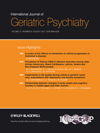Estimating the prevalence of dementia: cognitive screening in Glasgow nursing homes
Abstract
Objectives
The purpose of this study is to establish existing levels of dementia in nursing homes.
Design
The design was a randomised sample of every sixth nursing home resident in Glasgow City. Cognitive testing of 341 residents was carried out using the Standardised Mini Mental State Examination (SMMSE). For clients who had difficulty participating, the Functional Assessment Staging Tool (FAST) was used. Existing dementia diagnoses were compared with the prevalence indicated through cognitive testing.
Main outcome measures
Standardised Mini Mental State Examination and the FAST were used.
Setting
This study was conducted in the nursing homes in the Glasgow City Council Local Authority, Scotland, UK (N = 49). Forty-eight homes participated in the study and one declined.
Participants
The participants were residents of the nursing homes in Glasgow City, including those in existing dementia units (sample = 422 of population 2532); 19 declined and 403 participated.
Results
Two hundred thirty-four (58%) residents already had a diagnosis of dementia written in their care plans. One hundred twenty-eight residents (31.8%) without diagnosis of dementia in their care plans scored within the range of possible dementia (less than 24/30 on the SMMSE). A group of 55 (13.6%) residents had no diagnosis of dementia but had some type of cognitive impairment recorded in their notes and scored within the range of possible dementia on the SMMSE.
Conclusion
Existing levels of dementia diagnosis are 58%. This study finds an additional 31.8% of residents without a diagnosis of dementia who score within the range of possible dementia, giving a ceiling of 89.8%. It appears that underdiagnosis of dementia exists within this 31.8% group. Copyright © 2011 John Wiley & Sons, Ltd.




